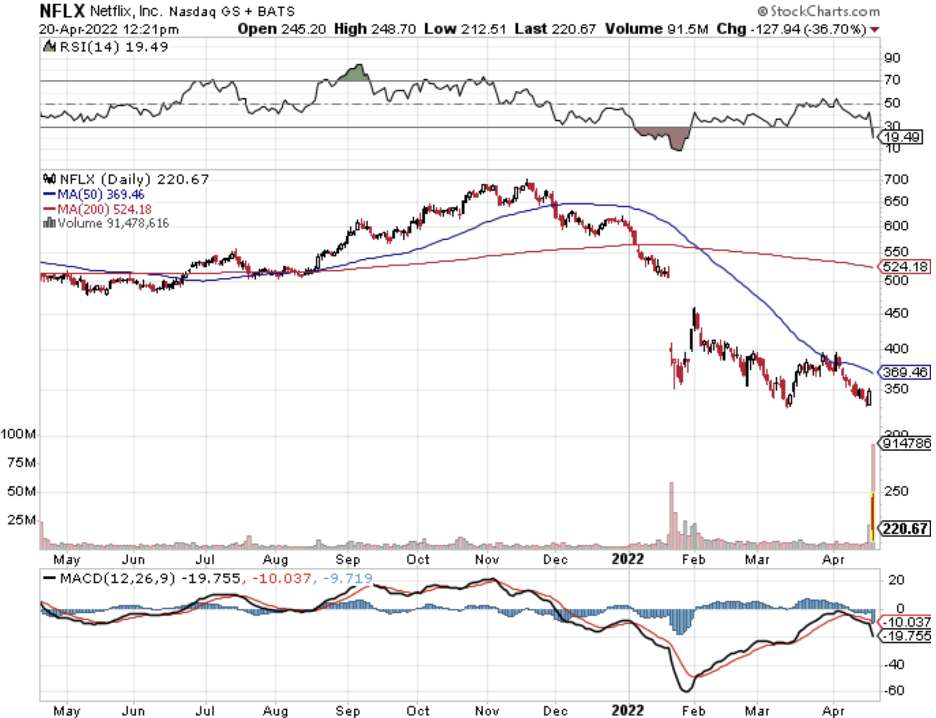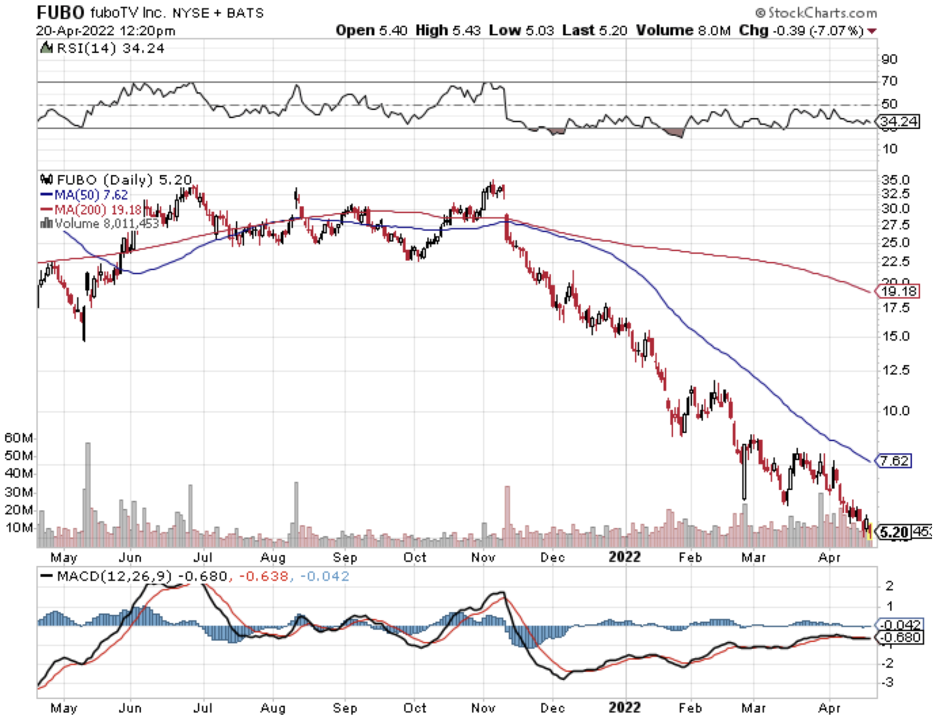Mad Hedge Bitcoin Letter
April 21, 2022
Fiat Lux
Featured Trade:
(SHOPIFY BOOSTS DIGITAL GOLD)
(BTC), (SHOP), (MCD), (WMT)

Mad Hedge Bitcoin Letter
April 21, 2022
Fiat Lux
Featured Trade:
(SHOPIFY BOOSTS DIGITAL GOLD)
(BTC), (SHOP), (MCD), (WMT)

People aren’t going to wake up the next day and find that Bitcoin (BTC) is suddenly the de-facto global payment system.
There are steps that need to be taken for it to get to that point.
How I see it – the path to further adoption will go through the e-commerce systems in digitized form.
This makes sense on a lot of fronts.
It’s no secret that e-commerce is usurping the status quo of brick-and-mortar shops.
That process was accelerated by the health phenomenon over the past two years.
If Bitcoin get can the likes of Amazon to allow Bitcoin payment, then that would be considered a massive victory.
That needs to happen before government services or utility payments allow Bitcoin payments.
It also needs to happen before big government install regulations too onerous that it won’t come to fruition.
The short-term positive news is that payment network Strike has announced integrations with Shopify (SHOP), an alternative payment processor Blackhawk Network, which will make it easier for global merchants to accept Bitcoin payments.
Bitcoin Lightning Network, a second layer built on top of the Bitcoin blockchain, will convert BTC payments into dollars quickly, relieving merchants of complexities associated with actually holding Bitcoin.
I must admit, Shopify is no Amazon, but baby steps need to happen somewhere and Shopify is a reputable e-commerce company as it stands.
Yet Shopify’s $4.5 billion of annual sales is dwarfed by Amazon’s $450 billion in annual sales and that matters.
Scale is everything in tech and hitting singles doesn’t make quite the dent or simply will take too long for the results to become meaningful.
Shopify will be able to take advantage of previously untapped global markets and purchasing power, as well as save money with low-cost payment processing through accepting Bitcoin payments.
Merchants will be able to interact with the Bitcoin network, and users will be able to make purchases privately throughout the United States, taking advantage of the cheap, instant, and open access that Bitcoin offers.
More than 400,000 storefronts will now accept Bitcoin through the Lightning Network, and any merchant is welcome to join through SHOP.
What was once hard to imagine is now becoming a reality. The future looks like it will bring millions of storefronts across the US accepting Bitcoin in the near future. Other countries may follow suit after seeing the success of this nation-state Bitcoin usage.
Sadly, financial institutions have been woefully inadequate to meet the needs of an increasingly digital consumer, and it’s now evident they are generations behind.
If we really think about it, there has been no innovation in the payment systems since 1949.
The launch of the Bitcoin payment system has revolutionized and disrupted well-established traditional credit card networks like Visa and MasterCard, bringing a new financial world order.
Several examples show how crypto adoption boosted a nation's economy, including Argentina, which adopted Strike’s Lightning payments system and saw its GDP rise 10.3% in 2021, the highest rise since 2004. Another example is El Salvador, which adopted Bitcoin as legal tender with the help of Strike and saw its GDP grow by double digits for the first time recently.
I am eagerly awaiting McDonald’s (MCD) and Walmart’s (WMT) announcement that they will start accepting Bitcoin.
That will really move the needle.
If some of these big players come on board, Bitcoin will also benefit from reduced volatility as well inspire the incremental investor to hold Bitcoin as a store of value.
Yet the wait goes on as Bitcoin is slowly accepted around the world and the more sovereign nations and large corporations that come into the fold, there is no doubt in my mind that this will be a main driving force behind higher Bitcoin prices.
Global Market Comments
April 21, 2022
Fiat Lux
Featured Trade:
(IS AIRBNB YOUR NEXT TEN BAGGER?),
(ABNB), (WYNN), (H), (GOOG), (PYPL)

Mad Hedge Technology Letter
April 20, 2022
Fiat Lux
Featured Trade:
(PEAK EYEBALLS)
(DIS), (CURI), (ROKU), (PTON), (ZM), (WBD), (FUBO), (NFLX)
Online streamers now have no pricing power.
Remove jacking up prices from the equation and streamers like Netflix (NFLX) and Disney (DIS) look quite mediocre and that’s what the 35% drop in NFLX shares are telling us.
NFLX Ahh factor has vanished.
It used to be that they knew they could raise prices whenever they wanted and that tool in their kit kept investors on board.
CNN+’s dismal foray into pay tv was another red flag when owner Warner Bros. Discovery (WBD) decided to pull all marketing spend because of the paltry viewing results.
There’s just too much competition out there and instead of creating more leeway, growth was pulled forward the past 2 years, and now the chickens are coming home to roost.
Shelter-at-home stocks like Peloton (PTON) and Zoom (ZM) are now surplus to requirements.
It was just not that long ago, that fresh streaming TV options launched at a frenzied pace.
With many subscription services available, streaming entertainment became ubiquitous in U.S. homes as consumers spent large quantities of time and money on streaming media.
As economies reopen following the end of the health situation, and consumers spend more time outside of their homes, there still are just other things to do like going outside.
The idea that there are still many years of streaming growth lie ahead for the streaming industry has turned out to be an utter fallacy.
These are some tech companies impacted.
The much-anticipated Disney+ streaming service was launched in late 2019, just in time for the health situation.
It added tens of millions of subscribers worldwide in its first year and quickly became the second-largest subscription streaming service after Netflix. Disney also owns the streaming services Hulu and ESPN+ in the U.S. but they still don’t turn a profit on many of these streaming assets yet.
It is unlikely that new content will reverse generating excessive losses.
Better Disney stick to the amusement parks.
Streaming TV has been a boon for the smart TV and streaming device maker.
Roku has become the largest TV platform in the U.S., distributing content via The Roku Channel and acting as a hub for households to manage all of their streaming subscriptions.
Roku distributes its smart TV software and streaming devices at minimal cost, making money instead on advertising and by managing subscriptions.
With peak eyeballs on streaming, don’t expect any explosive growth from Roku, in fact, they could go with a whimper and wait for a buyout.
This is a warning sign for any tech company that chooses to not produce their own in-house content and relying on others to draft the narrative of future health is awfully dangerous in a zero sum game.
Streaming service fuboTV, a relative newcomer to the streaming media industry, went public in 2020.
This small service has gained popularity as a live TV platform, and it’s a top option for those who want to watch live sporting events.
The smaller they come, the harder they fall.
Smaller streaming companies have little recourse when multiple exogenous forces impact the company.
fuboTV is nowhere near profitability and has lost close to half a billion dollars in each of the past 2 years.
Public companies are often harangued for going ex-growth the second they are tradable in New York, and this is the epitome of what I am talking about.
The stock has gone from $35 to $5 today in the past 5 months.
Don’t catch a falling knife here.
CURI is another newbie to the dying streaming industry.
This streaming media company focuses on documentaries and science content and was founded by Discovery’s
CURI is competing against some well-entrenched rivals in the non-fiction TV space, including Discovery and Disney’s National Geographic (available on Disney+).
The young company keeps its content creation costs relatively low since it focuses on educational material and partners with universities, but who really wants to see this type of content anyway.
This company sounds boring and naïve.
CURI’s stock price has gone from $17 to $2 in the past 5 months.
Avoid like the plague!




When John identifies a strategic exit point, he will send you an alert with specific trade information as to what security to sell, when to sell it, and at what price. Most often, it will be to TAKE PROFITS, but, on rare occasions, it will be to exercise a STOP LOSS at a predetermined price to adhere to strict risk management discipline. Read more
Global Market Comments
April 20, 2022
Fiat Lux
Featured Trade:
(TESTIMONIAL),
(TEN MORE TRENDS TO BET THE RANCH ON),
(AAPL), (AMZN), (GOOGL), (TSLA), (CRSP), (EDIT), (NTLA)
Mad Hedge Biotech and Healthcare Letter
April 19, 2022
Fiat Lux
Featured Trade:
(A BUDDING UNDERDOG TO DOMINATE THE ALZHEIMER’S BATTLE)
(SAVA), (BIIB), (LLY), (RHHBY), (ABBV), (AMGN)
One of the most significant unmet medical needs worldwide is the treatment of Alzheimer’s Disease (AD).
With over 6 million people affected in the US alone and roughly 40 million globally, this number is projected to double by 2050 as the population ages and more individuals live longer lives.
That’s why it comes as no surprise that even though the Centers for Medicare & Medicaid Services decided to limit the coverage of Biogen’s (BIIB) AD drug, Aduhelm, more and more drugmakers continue to move forward with their own candidates.
Eli Lilly (LLY) continues to work on Donanemab, which could be available for review by mid-2023. Meanwhile, Roche (RHHBY) is anticipated to release data on Gantenerumab by the end of 2022.
Among the drugmakers pursuing this field, one name continues to rake in positive reports: Cassava Sciences (SAVA).
Cassava’s lead AD drug candidate is Simufilam, a small oral pill. Thus far, this has shown no safety issues and even released the best clinical AD data.
Notably, this is the only treatment that demonstrated tangible cognitive improvement for longer than 6 months in the clinical studies for AD.
The fact that Cassava’s candidate bested Donanemab and Gantenerumab, which both received breakthrough designations, and Aduhelm, which got an accelerated approval, indicates its candidate’s strong potential.
Between their promising results, convenient storage of the pill, easy dosing method, impressive safety data, and the vast unmet medical market, Simufilam could very well be hailed as the best-selling AD treatment the moment it gains approval.
Another indicator of Simufilam’s promise is the lack—or even absence—of insider trading within Cassava in the past years.
Typically, company insiders know more about the projects than anyone else. Strong insider selling is generally followed by a fall in a company’s stock price.
This has not been spotted anywhere in Cassava, with multiple insiders taking on very big stakes in the company.
However, the strongest indicator for Cassava’s impending win is Simufilam being in clinical progression. In fact, it’s already dosing in Phase 3 trials.
While other drugmakers working on an AD treatment may have promising options, the earlier a candidate is in the clinical trials, the higher the risk of failure and the longer it’ll take to be commercialized.
Each step forward in clinical trials is basically a way to “de-risk” the candidates, which leads to an increased value of the company.
Naturally, one of the questions raised when dealing with a biotech not as large as AbbVie (ABBV) or even Amgen (AMGN) concerns financial health.
Cassava’s recent financial filings showed that the company has roughly $240 million in cash and $0 debt.
Looking at their workflow, Cassava typically burns about $9 million every quarter.
As they ramp up their Simufilam trials, this is obviously expected to change.
After all, Phase 3 trials tend to cost more. So, the company anticipates a bump in spending to reach $12.5 million to $15 million per quarter this 2022.
While this is a substantial increase in capital expenditure, the jump remains within reasonable projections of the price of Phase 3 trials.
Taking into consideration the higher burn rate of roughly $15 million every quarter, Cassava would still have sufficient cash to operate for 16 quarters or 4 years without the need to resort to any additional financing rounds—at least for Simufilam.
If it fails, investors would already know whether Simufilam was a success.
That means if Cassava does pursue financing efforts, it would be for new projects and not for this particular AD treatment.
The market has not been kind to the biotechnology sector lately. It’s because the market tends to overreact to negative news.
Farsighted investors who recognize the enduring potential of a company—even at its vulnerable periods—can sometimes reap outsized returns if they turn out correct.
However, a successful strategy for some investors is to bet on companies that other investors are afraid to touch.
Nevertheless, it’s still prudent to keep in mind that investing in a roller coaster like Cassava means preparing yourself for an unexpected and possibly wild ride.
Mad Hedge Bitcoin Letter
April 19, 2022
Fiat Lux
Featured Trade:
(HASH RATE COLLAPSE)
(BTC)
Legal Disclaimer
There is a very high degree of risk involved in trading. Past results are not indicative of future returns. MadHedgeFundTrader.com and all individuals affiliated with this site assume no responsibilities for your trading and investment results. The indicators, strategies, columns, articles and all other features are for educational purposes only and should not be construed as investment advice. Information for futures trading observations are obtained from sources believed to be reliable, but we do not warrant its completeness or accuracy, or warrant any results from the use of the information. Your use of the trading observations is entirely at your own risk and it is your sole responsibility to evaluate the accuracy, completeness and usefulness of the information. You must assess the risk of any trade with your broker and make your own independent decisions regarding any securities mentioned herein. Affiliates of MadHedgeFundTrader.com may have a position or effect transactions in the securities described herein (or options thereon) and/or otherwise employ trading strategies that may be consistent or inconsistent with the provided strategies.
